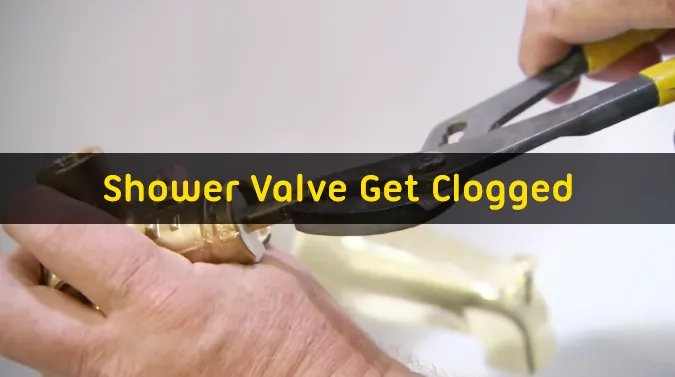Last Updated on May 23, 2023
Is the flow of water in your shower blocked? Clogged valves are a common household plumbing problem. The cause may be mineral build-up, dirt, and hair getting stuck over time. Or even just from improper installation to begin with. Whatever it is that’s causing the blockage, don’t hesitate to get it sorted.
Hard water can leave behind mineral residue that hinders the proper functioning of valves. And potentially leading to decreased water flow and inconsistent temperatures. Without routine maintenance or correct installation, clogs may also form, ultimately blocking off any passage of fluid.
Let’s explore the issue of shower valve clogging and learn what to watch out for to prevent it. We’ll discuss potential causes and take a look at ways we can ensure our valves stay working correctly down the line.
Can A Shower Valve Get Clogged: 7 Causes
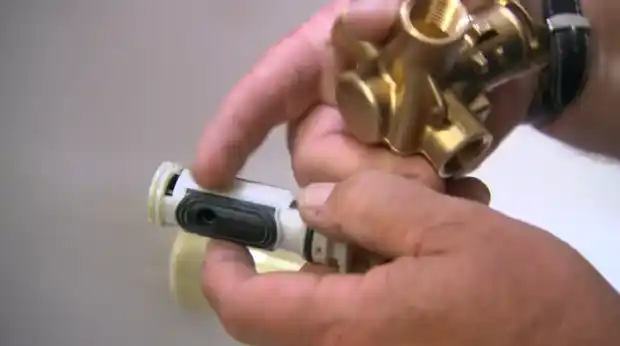
Cause 01. Mineral Buildup
Mineral buildup is one of the primary causes of clogging in shower valves. Have you ever heard of hard water? It’s water that has a high concentration of calcium and magnesium, which can get deposited in your pipes and valves over time. This forms a mineral scale that gradually builds up, clogging them.
This mineral buildup eventually clogs the valve, disrupting the normal flow of water and impairing its performance.
If you want to prevent mineral deposits and clogged valves, get a water softener or some kind of filtration system for your water supply. This way, the calcium, and magnesium won’t build up in your pipes and cause blockage.
Cause 02. Hair and Other Dirt
Another common source of shower valve clogging is the hair and other dirt accumulating within the valve. Have you ever experienced a slowdown or stoppage in your water flow? That can be caused when hair gets stuck between the two rubber washers inside the valve stem, which stops it from closing correctly.
To keep your shower valve working optimally, you should give it a regular clean. Use something like vinegar or baking soda to flush out any debris that might be blocking the valve. That way, it’ll stay in good condition and prevent any slowdowns or stoppages.
Cause 03. Improper Shower Valve Installation
Improper installation can also lead to clogging in shower valves. Poorly installed components in valves can lead to air pressure buildup, which causes decreased water flow or even shut off, despite short-term use.
Installing a shower valve correctly is important for ensuring its optimal performance. If you’re unsure how to do so correctly, it’s best to seek professional assistance from a qualified plumber for the best results.
Cause 04: Lack of Maintenance
The leading cause of clogging in shower valves is a lack of regular maintenance. Regular maintenance on your shower valve, including cleaning and checking for any signs of corrosion or leakage, can help prevent clogging over time.
Over time, deposits from hard water or other materials build up in the pipes, resulting in clogs and, eventually, leaks. If you have noticed any signs of clogging in your shower valve, take action right away and regularly assess the condition of your shower valve.
Regular maintenance is important to keep your pipes and valves operating properly. Clean out any deposits inside the pipes with an abrasive cleaner or vinegar solution. You should apply lubricants on the valve’s moving parts. This will make sure they remain in good condition and won’t get stuck.
Cause 05: A Leakage in the Shower Valve
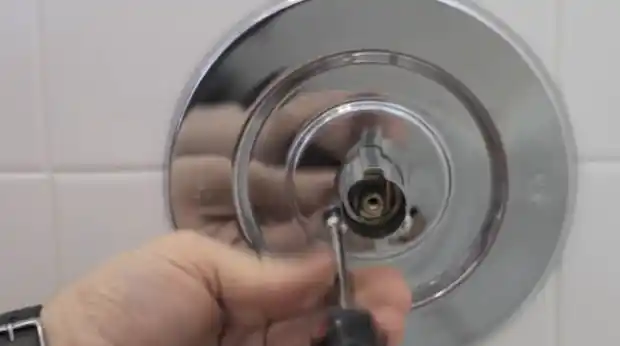
Clogging caused by a leak in the shower valve is often more difficult to detect than other blockages. A leak within the inner workings of the valve can cause debris to accumulate within its walls and create a tight seal that prevents water from flowing freely.
In addition to this, if there is a crack or gap in one part of the pipe system, it can trap particles and create a blockage further down the line when these particles are unable to be flushed away.
Inspect all parts of your plumbing system regularly for any signs of wear or damage, which could be causing blockages or leaking over time.
Cause 06: Corrosion in Metal Parts
Corrosion in metal parts is another common cause of clogs within shower valves. As metal parts age, their surfaces may become susceptible to corrosion-causing elements such as moisture, acid rain, salt air, and more.
When water sits for a long time, it can cause rust and damage the parts of your plumbing system. This rust can build up and block small things like washers or pipes from working, which then causes water to back up into other places like showers and bathtubs.
It’s important to check metal parts often for rust. This is so that you can catch it early and not pay a lot later for repairs caused by rust blocking things up or ruining metal seals.
Cause 07: Blockages in the Main Water Supply
Blockages within a home’s primary water supply line can also lead to clogging issues with shower valves and other plumbing fixtures throughout a home.
This is because when there is an obstruction within any part of our plumbing system, whether it be from debris or sediment build-up.
This restricts water flow and causes some areas that should be receiving adequate amounts of pressure for proper functioning not to receive enough.
Leading to eventual clogging issues throughout the entire system, including our shower valves.
5 Signs of A Clogged Shower Valve
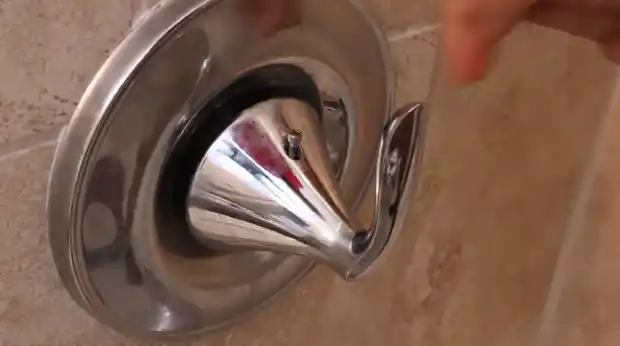
Sign 01. Reduced Water Flow
One sign that a shower valve is clogged is decreased water flow. When the valve is blocked, the water coming through the shower head will decrease significantly compared to when it was usually working.
The water pressure may also be noticeably weaker than before, and it may take longer for hot and cold water to reach the desired temperature. Sometimes, the water may even come out in spurts instead of flowing steadily.
Sign 02. Uneven Water Temperature
Shower valve clogs may also result in inconsistent or irregular temperature control. Sometimes when you take a shower, the water temperature keeps changing from too hot to too cold.
You might also have trouble getting the water warm enough even when you turn up the heat knob. This could be caused by build-up inside the valve preventing proper mixing between hot and cold water.
Sign 03. Complete Blockage of Water Flow
If you try to turn on your shower, but no water comes out, and you can’t increase the pressure, then it’s likely that your shower valve is clogged.
It looks like something has clogged the valves in your system. This means that nothing is allowed to pass through your pipes or faucets. The stuff blocking them up is hard and won’t move easily.
Sign 04: Loud Noise from Shower Valve
A clogged shower valve may cause the water pressure to become erratic and inconsistent. In a typical situation, water should come out of the valve in a steady stream. However, if it is clogged, it may fluctuate between gushing out too quickly and then sputtering or dripping out slowly.
It can be annoying to take a shower if you need to change the water pressure. You might have to do this every few moments so the water stays at the same strength. This inconsistency can cause other issues, such as insufficient hot water or scalding due to sudden temperature spikes.
Sign 05: Temperature Fluctuations
Another sign of a clogged shower valve is an uncharacteristically loud noise when you turn on the water. It’s normal for there to be some sound coming from your pipes when you turn on the tap.
This is usually just air being released, but if that sound is particularly loud and harsh, it could indicate that there is something blocking up your valve.
This is because debris or limescale buildup can obstruct the smooth running of water through the pipe, which causes turbulence leading to increased noise.
This blockage can even lead to vibrations throughout your home’s plumbing system, which can be quite intrusive if left unchecked.
In Which Parts of the Shower Valve Clogging Can Occur?
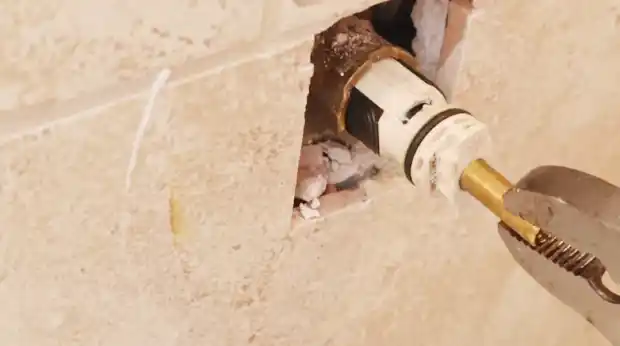
Internal Passages
Internal passages are the tiny inner channels and passageways of the shower valve that connect the different components. Clogging can occur in these passages due to mineral deposits, lime scale, and other debris that builds up over time.
This clog is more difficult to diagnose because it is located inside the valve body and cannot be seen without disassembling the unit. To remove a clog caused by a mineral buildup, it may be necessary to use specialized tools such as an acid flush or descaling kit.
Aerator
An aerator is a spray attachment that fits on top of the showerhead or faucet spout to regulate the flow rate, reduce splashing, and save water usage. Clogs in this area of the valve are generally caused by mineral deposits from hard water buildup over time.
In some cases, removing the aerator and soaking it in white vinegar for several minutes can help dissolve any build-up and restore normal flow levels. If this doesn’t work, you may need to replace the aerator altogether.
Showerhead
A showerhead is a device installed at the end of a pipe connected to a shower valve that controls water pressure, temperature, and flow rate when activated. Clogs in this part of the system can be caused by mineral buildup from hard water or from soap scum residue that accumulates on its surfaces over time.
For minor clogs related to soap scum buildup, simply unscrewing and cleaning with white vinegar may do the trick. For harder mineral deposits or for more severe clogs due to corrosion or scale buildup on internal surfaces, it may be necessary to replace the entire showerhead itself.
Cartridge
The cartridge is important for your shower valve system. It helps keep water at the right temperature and controls how much water comes out when you turn a handle or knob.
It’s essential to maintaining an optimal bathing experience. The valves can get clogged. This is because of debris like limescale that builds up on the inside. If it is not cleaned, it can stop the valve from working properly.
Clogs can be tough to get rid of. Traditional methods like flushing with white vinegar or using descaling kits may not work. You might need to replace them instead.
Thermostatic Valve
A thermostatic valve provides ultimate convenience, automatically adjusting water pressure and temperature according to your preset parameters. Enjoy hassle-free showers with the simple setup of this modern device, and never worry about manually changing settings again.
Thermostatic valves can present severe clogging issues due to complex designs predisposed to mineral accumulation around the seals. If neglected, not only may they be blocked but also breakdown altogether.
Therefore regular servicing and maintenance are highly recommended for them to remain functional long-term. To sum things up, clogged shower valves can cause a wide range of issues in your home ranging from reduced water flow to complete blockages.
The build-up of minerals and other debris over time is usually the primary culprit for these clogs. This issue can be prevented with proper installation and regular maintenance.
It is important to fix a clogged shower valve as soon as possible. Otherwise, it can cause bigger plumbing problems later.
Can I Clean A Clogged Shower Valve Myself?
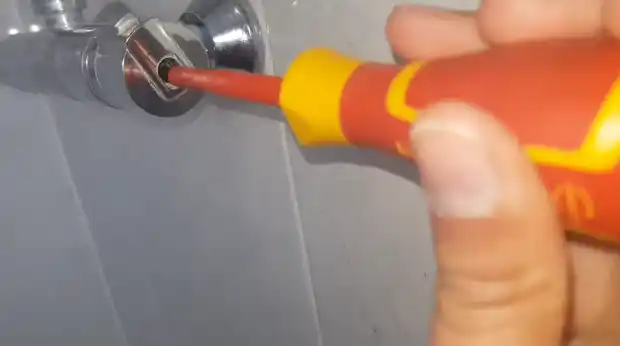
Cleaning a clogged shower valve yourself is possible, but it is often best to hire a professional plumber as they will have the proper tools and know-how. If you do decide to clean the shower valve yourself, first turn off the water to the valve and open any valves attached to the system.
Then remove any components or covers blocking access so you can properly inspect and clean the inside of the valve. To remove contaminants from within, use a thin wire brush or a cloth wrapped around a small screwdriver.
To remove mineral deposits, use vinegar, baking soda, and hot water. After your cleaning is complete, test all parts of the system before turning on the water again.
How Often Should I Clean My Shower Valve To Prevent Clogs?
It is essential to clean your shower valve regularly to prevent clogs. The shower valve should be cleaned at least once every six months, depending on your usage and water hardness.
This will help ensure that any won’t accumulate inside do not build up within the valve body and cause it to become blocked over time. Flushing out mineral deposits with vinegar or citric acid can help prevent future clogging.
Maintaining Your Shower Valve: A Guide to Keeping it Clog-Free and Long-Lasting
Keeping your shower valve in good condition is important if you want to avoid clogs, and the best way to do this is by hiring a licensed plumber.
Check the cartridges and aerators often. Don’t use too much water pressure when you take showers. Look for any metal parts that may be corroding.
Whatever you do, don’t try to repair or clean a shower valve yourself. That’s always best left to the professionals. The shower valve should last a long time if it is maintained and cared for properly.

